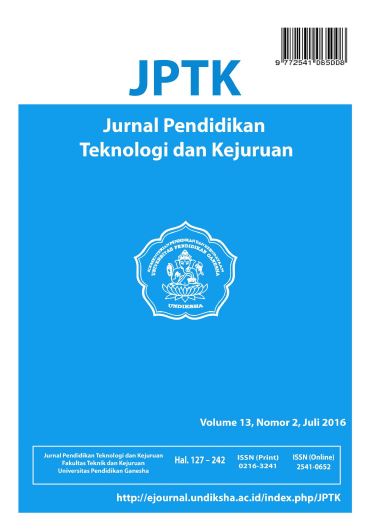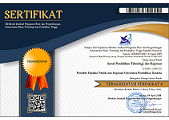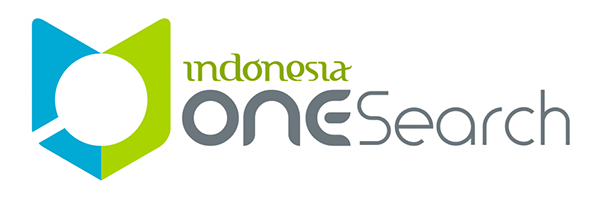STUDI KOMPARATIF MODEL PEMBELAJARAN TALKING STICK DAN SNOWBALL THROWING TERHADAP HASIL BELAJAR TEKNOLOGI INFORMASI DAN KOMUNIKASI (TIK) SISWA KELAS XI SMA NEGERI 1 SERIRIT TAHUN AJARAN 2015/2016
DOI:
https://doi.org/10.23887/jptk-undiksha.v13i2.8521Abstract
Abstrak
Pembelajaran TIK hendaknya dapat menyiapkan kondisi yang mendukung agar aktivitas dan kreativitas siswa memperoleh pengetahuan sendiri melalui proses belajar. Pemilihan model pembelajaran yang tepat sesuai karakteristik siswa akan membantu keberhasilan suatu pembelajaran. Penelitian studi komparatif akan membandingkan dua model pembelajaran, untuk mengetahui model manakah yang lebih baik. Tujuan penelitian ini untuk mengetahui(1) Pengaruh hasil belajar TIK siswa kelas XI di SMA Negeri 1 Seririt dengan menggunakan model pembelajaran Talking Stick dan Snowball Throwing, (2) Hasil belajar yang lebih tinggi antara model pembelajaran Talking Stick atau Snowball Throwing, (3) respon siswa terhadap penerapan model pembelajaran Talking Stick dan Snowball Throwing.
Jenis penelitian ini adalah eksperimen semu dengan rancangan Post Test Only With Non Equivalent Control Group Design. Pengumpulan data dilakukandenganmetodetespilihangandauntukmengukurranahkognitifdanujiketerampilanuntukranahPsikomotor. Data hasilbelajardianalisismelaluiujiprasyarat yaitu uji normalitas dan homogenitas dengan hasil ketiga kelompok berdistribusi normal dan homogen, dilanjutkan dengan ujihipotesismenggunakan Anova Satu jalur lalu dilanjutkan dengan uji berpasangan t-Scheffe.
Hasil uji anova satu jalur menyatakan terdapat pengaruh yang signifikan dalam penggunaan model pembelajaran Talking Stick, Snowball Throwing, dan konvensional. Karena terdapat pengaruh yang signifikan maka dilanjutkan dengan uji t-Scheffe dengan hasil terdapat perbedaan yang signifikan antara masing-masing pasangan. Kemudian dilihat dari rata-rata hasil belajar disimpulkan bahwa model pembelajaran Talking Stick lebih baik dengan rata-rata hasil belajar yang lebih tinggi. Sedangkanuntukresponmenggunakanmetodeangket. Hasil analisis angket model Talking Stick diketahui 36% respon sangat positif, 61% respon positif dan 3% respon cukup positif. Sedangkan untuk model Snowball Throwing diketahui 25% respon sangat positif, 67% respon positif dan 8% respon cukup positif.
Kata kunci: Studi Komparatif, TIK, Talking Stick, Snowball Throwing, hasil belajar, dan respon siswa
Abstract
TIK learning must have to prepared student’s activities and creativities to obtained the own knowledge by means of learning process. An appropriate learning model election agree with students characteristics would help an success learning. The comparative study research would have to compared both of learning model, to know which model was better. This research aimed to know (1) The influenced about the result of students’ TIK study used Talking stick and Snowball Throwing learning model (2) the highest result of study between Talking stick and Snowball Throwing
learning model (3) the students’ response toward Talking stick and Snowball Throwing learning model application.
Kind of this research was quasi experiment by Post Test Only with Non Equivalent Control Group Design. The data accumulation done by multiple choice tests to measured cognitive domain and skill test to psychomotor domain. The students’ result study analyzed by prerequisite test was normality test and homogeneity by the result of the three group which normal distribution and homogeneous, continued by hypothesis test used a strip Anova then continued by t-Sheffe
The result of one way onova exist a significance influenced on the used of Talking Stick leaarning model, Snowball Throwing and conventional. Because of thee was a significance difereences between each partner. Afterwards, seen from the result average of study can be concluded the Talking Stick learning model better than the higest result average of study. Meanwhile, the respond of used questionnaire method, the result of Talking stick model questionnaire known 36% very positive responses, 61% positive responses and 3% positive sufficient responses. Then, Snowball Throwing model known 25% very positive responses, 67% positive responses, and 8% positive sufficient responses.
Keywords : The Comparrative Study, TIK, Talking stick, Snowball Throwing, the
study result, students’ respond
Downloads
Issue
Section
License
Authors who publish with the JPTK agree to the following terms:- Authors retain copyright and grant the journal the right of first publication with the work simultaneously licensed under a Creative Commons Attribution License (CC BY-SA 4.0) that allows others to share the work with an acknowledgment of the work's authorship and initial publication in this journal
- Authors are able to enter into separate, additional contractual arrangements for the non-exclusive distribution of the journal's published version of the work (e.g., post it to an institutional repository or publish it in a book), with an acknowledgment of its initial publication in this journal.
- Authors are permitted and encouraged to post their work online (e.g., in institutional repositories or on their website) prior to and during the submission process, as it can lead to productive exchanges, as well as earlier and greater citation of published work. (See The Effect of Open Access)












